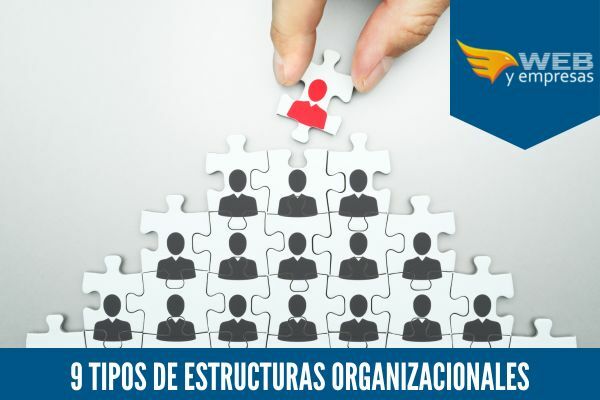The organizational structuresThey play a very important role within organizations, since they act as a guide in the way in which responsibilities are assigned and decisions are made through the chain of command, being essential to improve management and coordination in achieving company objectives avoiding duplication of efforts.

Advertisements
In today's business world, there are many types of organizational structures, the choice of an organizational structure depends on the ability to adapt to the needs of the business.
It is also important to mention that the choice of an organizational structure should reflect the company strategy, its environment, its size, its technology, and the skills of its leaders and employees.
Advertisements
In this article you will find:
What are organizational structures?
The organizational structures outline the how companies distribute their roles, responsibilities and lines of authority, acting as schematics that define how the different parts of an entity are interconnected, facilitating coordination and communication.
Depending on their objectives and contexts, organizations can adopt hierarchical, divisional, matrix structures, among others. These configurations They determine not only how decisions are made, but also how information flows and how the company adapts to external changes.
Advertisements
For Mario Brume (2019) the “The organizational structure is essential in all organizations, it defines the elements and characteristics of how it is going to organize, has the main function of establishing authority, hierarchy, chain of command, organizational charts and departmentalizations, among others.” (p. 6)
Basically, the organizational structure is the framework that guides the proper functioning and behavior of an organization.
Advertisements
Types of organizational structures
Some of the most common organizational structures are:
functional organizational structure
The functional organizational structure It is based on grouping employees and tasks according to the function or specialty they perform within an organization, being one of the most traditional structures within the business world.
Advertisements
It is designed to promote efficiency in the management of specialized activities, dividing them into departments such as finance, marketing, production, human resources, etc.; each headed by a leader who reports to the higher hierarchical level.
Its great utility is based on the fact that provides clarity on roles, responsibilities and lines of authority, facilitating supervision and decision-making.
Organizational structure by division
The organizational structure by divisionsegments a company into self-contained units based on products, services, geographies, or market segments, each division operates as an individual entity with its own resources, teams and goals, allowing for a more personalized approach tailored to your specific needs.
Unlike the functional structure, where the organization is grouped by specialty, the divisional structure focuses on products or markets. This means that the same company can have divisions dedicated to different products or regions, each with its own strategy and address.
This decentralization facilitates quick decision making and adaptability to changing market conditions; the structure by division is beneficial for large corporations with a variety of products or presence in multiple geographies, since allows a closer management and oriented to the local context or to the specific product, thus optimizing the response to the demands of the market.
Matrix organizational structure
The matrix organizational structure combines elements of functional and divisional structures, trying to take advantage of the best of both; With this design, employees have dual roles, that is, reporting to both the functional line and the leader of a specific project or product.
This duality allows for functional specialization, while maintaining the flexibility to work on transversal projects. For example, an engineer may report functionally to the engineering director, but also to a product development project leader.
matrix structure was designed to respond to the needs of organizations that face multiple demands and require a high degree of coordination; Many companies adopt this structure to foster collaboration and quickly adapt to changes. changing business environments, managing to balance efficiency and adaptability in an organizational framework dynamic.
Organizational structure by teams
The organizational structure by teams is based on grouping individuals according to specific projects or tasks rather than traditional functions or divisions, with this design, the focus falls on multidisciplinary teams that work together towards a common goal, taking advantage of the skills and knowledge of each member.
These teams can be temporary, formed for specific projects, or permanent, maintaining their cohesion in the long term; One of the main advantages of this structure is flexibility, since, teams can quickly adapt to change, innovate and make decisions without the need to go through multiple hierarchical levels.
In addition, by encouraging collaboration, communication is encouraged and creativity is enhanced. These types of structures are a powerful tool in environments that require speed and innovation, allowing the potential and performance of human talent to be maximized.
Network organizational structure
The network organizational structure, also known as "redarchy", represents a radical change in the traditional organizational design, because instead of a rigid hierarchy, the netarchy is resembles an interconnected network of nodes, where each node can be an individual, a team, or an external entity; entity approach it is based on collaboration, connectivity and fluid communication, prioritizing adaptability over a fixed structure.
Within a network, decisions do not necessarily come from the top, but emerge through interaction and collaboration between nodes, this fosters innovation and agility, since solutions and strategies can emerge from any network point.
Organizations that adopt this model are often open to change, highly digital, and learning-oriented. as it provides a dynamic framework for organizations seeking to break out of traditional molds and evolve quickly.
circular organizational structure
The circular organizational structure represents an innovative alternative to traditional hierarchical structures, which, instead of a pyramid with clearly defined levels of authority, The circular structure places the leader or central vision of the organization at the core, surrounded by concentric circles that represent different roles or functions.
In this model, communication does not flow from the top down as in a typical hierarchy, instead place, information and ideas circulate from the center to the outer circles and vice versa, promoting a more equitable and democratic exchange, reflecting a more collaborative and less authoritarian approach to management.
One of the main benefits of this structure is the removal of communication barriers, since all members have a closer proximity to the decision center, which can speed up processes and encourage innovation.
Horizontal organizational structure
The horizontal organizational structurecharacterized by few or no hierarchical levels between management and staffSince this structure is based on the idea of empowering employees, giving them greater autonomy and responsibility in their roles and decisions.
In a horizontal organization, communication tends to be direct and open, eliminating the traditional barriers that exist between different levels of a company; the emphasis is on collaboration, teamwork and the active participation of all members in decision-making.
These organizations tend to be more agile and flexible, able to quickly adapt to changes in the market or in the industry. In addition, by reducing bureaucracy and constant supervision, innovation and creativity among employees are encouraged.
Line and Staff Organizational Structure
The organizational structure of Line and Staffintegrates the clear chain of command of linear structures with the advantages of specialists or advisors in staff roles, with this model, the line positions represent the main hierarchical structure and bear the authority to make operational decisions, being directly responsible for achieving the objectives of the organization.
On the other hand, staff positions, although they do not participate in direct decision-making, offer support, advice and specialized knowledge to line roles; These roles may encompass areas such as human resources, finance, strategic planning, or public relations.
The strength of this structure lies in its ability to combine direct decision-making with specialized expertise, optimizing management and facilitating the implementation of strategies.
Linear organizational structure
The linear organizational structure, also known as vertical structure, is one of the Older, simpler models of organization are characterized by a clear line of authority that flows from the top down., where each individual has a direct superior and, in turn, may have subordinates in charge of him.
In this model, communication and decisions move through a single line of command, where authority and responsibility are clearly defined, which facilitates decision making and minimizes confusion regarding roles and responsibilities; The leader or manager at the top has the highest authority and is responsible for the direction and control of the entire organization.
Bibliographic reference
Mario Javier Brume González. ORGANIZATIONAL STRUCTURE. Editorial Seal: Itsa University Institution (978-958-52221). Barranquilla, 2019. ISBN 978-958-52221-1-3.


